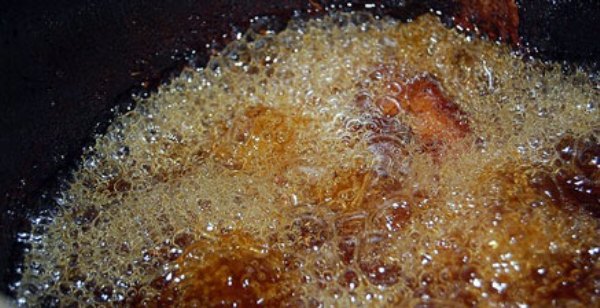Home » natural health »
Fatty Acids Part 3
THE BAD AND THE UGLY
An omega imbalance isn’t the only way in which dietary fat can endanger us. Often the problem is in the way fats and oils are made or used. Without margarine and the hydrogenated oils in vegetable shortening, to give one stark example, Americans and Britons could cut their heart attack risk in half. Margarine is but one example of nutritional errors that contribute to the harmful consequences of our intake of fat.
Processing and Packaging
In refined vegetable oils, which generally are any of the brands at a supermarket, the essential tty acids have often been destroyed or damaged by harsh chemical processes. In addition, the vitamin E and carotenoid content is almost always removed. Further, the oils’ glass or plastic containers are usually clear, which exposes the product to light damage that further deteriorates the oil. Even worse, they are rarely organic. You’ll do better by buying oils at health food stores, where the products are much more likely to have been prepared more responsibly and naturally.
HEAT FATS MINIMALLY
High heat initiates a variety of distinct molecular changes in food and creates disease-promoting elements like free radicals and lipid peroxides. Deep-frying, no matter what oil is used, turns a fat into a health threat. Stir-fried foods are better; as long as you avoid soya and other delicate oils that burn easily. Oils from peanuts and coconut are more stable and can better handle the higher heat used in stir-frying.
NOT MARGARINE – PLEASE!
I haven’t knowingly eaten anything that contains margarine since the 1970s, when Dr Carlton Fredericks first warned me of the threat it presents. Margarine is a primary cause of atherosclerosis and heart disease — not butter, as the American Heart Association would have you believe. Dr Fredericks, Adelle Davis, and other progressive nutritionists tried to alert the public bac in the 1940s, but their words were ignored. After animal experiments in the 1970s demonstrated that margarine can cause hardening of the arteries, the scientific community picked up the scent. The truth eventually came with all the authority о the most comprehensive health survey in medicine, the Harvar Nurses Study of 85,095 women. Margarine, because of its transfatty acids, correlated with the risk of heart disease more strongly than any other food — including butter; beef, pork and lamb. Hating other foods high in partially hydrogenated vegetable oil such as vegetable shortening, biscuits, cakes and chips also was significantly linked to a higher risk of heart disease.
KEEPING THEIR HEADS IN THE SAND
Since then the evidence has mounted into a near overkill, with countless studies showing that the trans-fatty acids i margarine and vegetable shortening increase LDL cholesterol, lower the beneficial HDL cholesterol and raise the overall risk of coronary artery disease. Medical journals now almost routinely warn doctors of the danger in margarine consumption, but nutritional policy makers are still reluctant to warn the general public. It is still the only fat recommended in diets created by the US National Cholesterol Education Program (NCEP). Most people still innocently believe they are being virtuous by using margarine. And many of them still innocently fall victim to hardening of the arteries, heart attack and premature death. Why do consensus panels engage in such a denial of the evidence? Compare the US response to that in Europe, where most countries have enacted stiff laws to limit the amount of trans-fatty acids in food. Many of the margarines sold in the United States are illegal in Europe.
Another way that fats can be processed to sabotage your health is through hydrogenation. This is another process that makes margarine worse than butter, but margarine is not the only example of a hydrogenated fat. Far from it: partially hydrogenated fats (because of their physical properties of providing long shelf life, which cannot be duplicated with natural substances) are ubiquitous in our diet.
Cereals, breads, prepackaged mixes, heat-and-serve meals, crackers, biscuits, shortening and almost all vegetable oils are partially hydrogenated to some degree. Many products sold in health food stores contain hydrogenated fats.
If you cannot avoid them, make sure they are not near the top of the list of ingredients (the ingredients list is arranged in order of decreasing quantity within the ‘recipe’). These hydrogenated fats worsen the lipid profile (HDL and LDL) and interfere with omega-3 and omega-6 metabolism, and they do so in proportion to the amount consumed.
How SUGAR BECOMES A BAD FAT
This is as good a place as any to plug my favourite dictum: avoid sugar. It, like any other carbohydrate or starch, will create . bad fats when consumed beyond what the body needs. Sugar is broken down into small molecules and is reassembled as fats.
These fats are called triglycerides. These are the fats that fill our fat cells, impair blood flow inside blood vessels and raise the risk of coronary artery narrowing. Sugar also raises insulin When too much insulin is circulating in the bloodstream, our triglycerides jump astronomically and our cholesterol ratios also worsen, with HDL falling and LDL rising.
As will be evident, the triglyceride-LDL cycle is of profound importance. You cannot escape this bad fat trap merely by not eating bad fats. You have to avoid sugar and limit carbohydrates as well. Remember, the prime steak that frightens fat- phobic folk was created by feeding a steer all the grains it wanted.






0 Comments
You can be the first one to leave a comment.